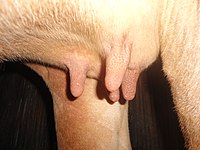
Photo from wikipedia
Antimicrobials are widely used to cure intramammary infections (IMI) in dairy cows during the dry period (DP). Nevertheless, the IMI cure is influenced by many factors and not all quarters… Click to show full abstract
Antimicrobials are widely used to cure intramammary infections (IMI) in dairy cows during the dry period (DP). Nevertheless, the IMI cure is influenced by many factors and not all quarters benefit from antimicrobial dry cow treatment (DCT). To evaluate the true effect of antibiotic DCT compared to self-cure and the role of causative pathogens on the IMI cure, a retrospective cross-sectional study was performed. The analysis included 2987 quarters infected at dry-off (DO). Information on DCT, causative pathogens, somatic cell count, milk yield, amount of lactation, Body Condition Score, and season and year of DO were combined into categorical variables. A generalized linear mixed model with a random cow, farm and year effect and the binary outcome of bacteriological cure of IMI during the DP was conducted. In the final model, a significant effect (p < 0.05) on DP cure was seen for the DO season and the category of causative pathogens (categories being: Staphylococcus aureus, non-aureus staphylococci, streptococci, coliforms, ‘other Gram-negative bacteria’, ‘other Gram positive bacteria’, non-bacterial infections and mixed infections), while antibiotic DCT (vs. non-antibiotic DCT) only showed a significant effect in combination with the pathogen categories streptococci and ‘other Gram-positive bacteria’.
Journal Title: Antibiotics
Year Published: 2023
Link to full text (if available)
Share on Social Media: Sign Up to like & get
recommendations!